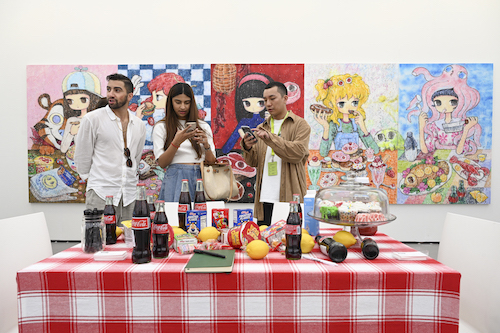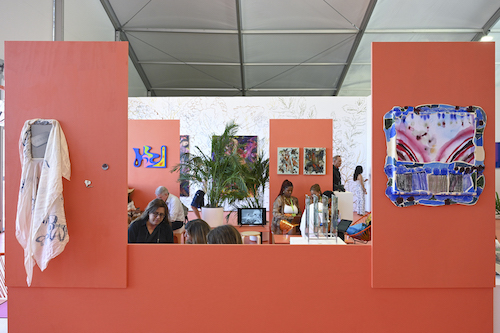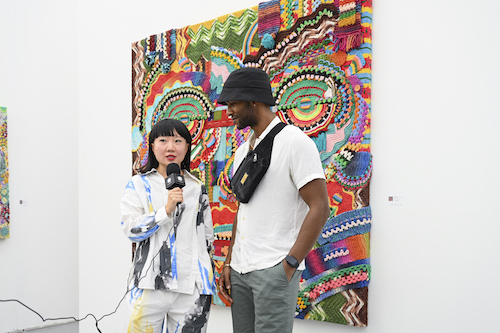Reviews - Ongoing - Estados Unidos
Clara Andrade Pereira, Omar López-Chahoud, Direlia Lazo
Reading time: 6 minutes

16.02.2023
Direlia Lazo talks with Omar Lopez-Chahoud y Clara Andrade Pereira from Untitled
Direlia Lazo: Since the promotion of this edition started it was perceived that Untitled was aiming to expand the platform beyond the week of the fair, what defined this edition compared to past experiences?
Omar Lopez-Chahoud: I would say the institutional links we have created. In this edition we presented several projects in collaboration with institutions, we generated spaces that functioned outside the structure of the galleries, more interactive, including a performance program to enhance dialogue and interaction with the public. We focused on creating a curatorial program that also resonated with the interests of the participating galleries and regions. In addition, in this edition, we enhanced the historical approach that in some way has been present in the narrative of the fair over the years. The launching of a new section dedicated to sound art, which opens with a sound installation by Val del Omar made in the 1960s, as well as the creation of an award that we will give every year to artists over 80 years old who have been influential to current generations.
Clara Andrade Pereira: Although it was the eleventh edition of the fair, we feel it as the tenth anniversary, due to the two previous years limited by the pandemic. After some complicated years for a sector that is active and nourished by physical presence, in my opinion, this year marks the consolidation of the fairs as the most relevant platform and tool for the expansion of the galleries’ programs outside their exhibition spaces. Untitled Art consolidates in its eleventh edition its presence in Miami Beach with a curatorial focus that continues to seek to give voice to the Americas, inserted in an international gallery context that also bets on the visibility of non-profit spaces, artist-run spaces and emerging art with the NEST sector. This year the fair was marked by a spirit of community and support for the art ecosystem, both local and global, where the Miami community was one of the focuses of attention. We also continued our network of cultural partnerships globally, this year with the launch of seven awards that expand the fair’s support of our galleries and artists.

DL: In the context of Miami Art Week, Untitled is undoubtedly the best positioned fair after Art Basel. Given the Miami context, it is inevitable to ask how Untitled looks at art produced in Latin America and what presence does it have at the fair?
OLC: One of my main objectives at Untitled has been to position Latin American artists in the international conversation. More than creating a space or section for Latin American art at the fair, I’m interested in strengthening the presence of Latin American art in an organic way, and making them interlocutors in a broader conversation. We cannot forget that the US is a Latin American country and the Latin presence in the United States, the construction of new identities is a reality, and that must be highlighted. Going back to what we were talking about the historical narrative, I bring as an example the installation by Venezuelan artist Yucef Merhi, as part of the special projects program. The installation revealed the correspondence between two eminent figures of 20th century culture, the French artist Auguste Herbin and the Venezuelan journalist Sofia Ímber, inviting the viewer to get to know perspectives from different contexts.
DL: Where is Untitled headed in 2023?
CAP: In 2023, Untitled Art will continue its efforts to present the most interesting curatorial proposals within the current art ecosystem, seeking to expand its international reach as a reference in the global fair scene. Initiatives such as NEST, the fair’s two-year-old youth sector, will be expanded in order to welcome and support proposals from the youngest, most experimental and non-profit spaces. In addition to continuing the interest in multidisciplinary artistic creations where digital art and performance take on a radical importance. We will continue with strategic cultural partnerships to continue creating possibilities for our galleries and artists beyond the enclave of the fair. We will also work with robust programming throughout the year, with activations that help us make visible areas of interest and research for our curatorial team outside the sands of Miami Beach. It is also essential to continue strengthening our institutional ties, counting on the attendance of the most relevant agents of contemporary art today, as well as educating, attracting and dialoguing with new audiences, a young but vital audience for the development and evolution of art collecting in the coming years.

DL: In your opinion, what keeps the trade fair format alive? Precisely now with all the different technologies involved where the virtual experience has taken center stage.
OLC: Digitalization is undoubtedly transforming artistic promotion platforms, amplifying the reach of new audiences and at Untitled we are very aware of this phenomenon. I see technology as a tool to be integrated according to the needs. For example, the collaboration we made with Vortic, which allowed us to develop our NEST section for more emerging projects, which usually in their early years cannot assume the costs of fairs, in this way we provide them with a virtual space, with global access, to present their projects. We are interested in continuing to strengthen the curatorial discourse, institutional links, creating programming beyond the week of the fair and accompanying the galleries in their programming throughout the year.

CAP: I believe that 2023 is the year in which the central importance of art fairs and their role within the contemporary art ecosystem will be consolidated. I agree with Omar that it is essential to innovate and remain active in all the different aspects that technology can bring to the art business, in terms of accessibility, archiving, transparency, democratization and improvement in terms of environmental impact. This past 2022 the fair broke attendance and sales records. We had a loyal audience of collectors, institutions, independent curators, art professionals and other agents of the sector, and we also welcomed a younger audience with a growing interest in contemporary art collecting. Miami Art Week is consolidating its position as one of the fundamental commercial centers for contemporary art in the United States, and Untitled Art as the platform that provides a platform for both discovery collecting, study and research, and for proposals already consolidated at the historical and institutional level.
![]()
23.03.2024
Opinion Cartografía sentimental de la brutalización en curso Argentina, Latinoamérica
Duen Sacchi
22.03.2024
Marginalia
(Español) La Revuelta
08.03.2024
Opinion
María Galindo
Comments
There are no coments available.